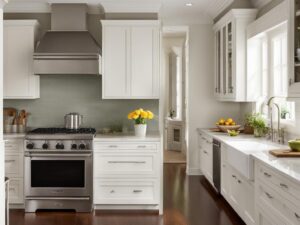When it comes to enhancing the heart of your home, you have two primary options: updating your kitchen or undergoing a full remodel. Each choice offers unique benefits and considerations, making it crucial to determine which approach aligns best with your goals and budget. In this comprehensive guide, we’ll explore the differences between a kitchen update and a remodel, helping you make an informed decision for your home.
Kitchen Update
Definition:
A kitchen update involves making cosmetic changes and relatively minor adjustments to refresh the look and functionality of your kitchen without a complete overhaul.
A kitchen update is a fantastic way to breathe new life into one of the most important spaces in your home without the extensive time and cost of a full remodel. It focuses on making cosmetic changes and minor adjustments to enhance the aesthetics and functionality of your kitchen. In this guide, we’ll explore the world of kitchen updates, providing insights into the process and tips to help you create a stylish and modern kitchen that perfectly suits your needs.
Step 1: Define Your Goals
Before you begin your kitchen update, it’s essential to define your goals. What aspects of your kitchen are you looking to refresh or change? Common goals include updating the cabinet finish, changing the color scheme, replacing hardware, and adding modern fixtures.
Step 2: Evaluate Your Budget
Establishing a clear budget is a crucial step in your kitchen update project. Consider how much you’re willing to invest in the update and allocate funds to different elements such as cabinets, countertops, lighting, and appliances.

Step 3: Choose a Color Palette
Selecting a color palette is one of the most impactful decisions in a kitchen update. Opt for colors that match your style and create the ambiance you desire. Neutral colors like white, gray, and beige are timeless choices, but bold colors can add personality and a contemporary feel.
Step 4: Refinish or Replace Cabinets
Cabinets play a significant role in your kitchen’s aesthetics. You can choose to refinish your existing cabinets, which involves sanding and repainting or re-staining, or replace them if you’re looking for a more extensive change. Consider shaker-style cabinets for a modern and versatile look.
Step 5: Update Countertops and Backsplash
Your countertops and backsplash are focal points in the kitchen. Updating them can transform the space. Granite, quartz, and butcher block countertops are popular choices, while subway tile or mosaic backsplashes can add a touch of elegance.
Step 6: Upgrade Appliances and Fixtures
Replacing outdated appliances and fixtures with modern, energy-efficient options can make your kitchen more functional and stylish. Stainless steel appliances are a timeless choice, and sleek, high-arc faucets can add a touch of elegance.
Step 7: Lighting and Accessories
Consider installing modern and energy-efficient lighting fixtures, such as pendant lights or under-cabinet lighting. Don’t forget the power of accessories like colorful dishes, decorative containers, and stylish kitchen tools to add a personalized touch.
Step 8: Final Touches and Clean-Up
Once the updates are in place, don’t forget the finishing touches. Add fresh paint, clean the space thoroughly, and ensure everything is in working order before enjoying your updated kitchen.
Benefits of a Kitchen Update:
Cost-Effective:
Kitchen updates are generally more budget-friendly than full remodels. You can achieve a fresh, modern look without breaking the bank.
Time-Efficient:
Updates take less time to complete compared to a full remodel. This means minimal disruption to your daily life, allowing you to enjoy your improved kitchen sooner.
Enhanced Aesthetics:
An updated kitchen can breathe new life into the space, giving it a fresh and modern appearance. You can transform the look and feel of your kitchen without the need for extensive construction.
Personalized Touch:
Through an update, you have the freedom to select elements that match your style and preferences. This allows you to create a kitchen that reflects your unique personality and taste.
Improved Functionality:
While primarily focused on aesthetics, updates can also enhance the functionality of your kitchen. This may include the addition of more efficient appliances, improved lighting, and better storage solutions.
Increased Home Value:
A well-executed kitchen update can significantly increase the value of your home. It’s an investment that not only benefits your day-to-day living but also pays off when it comes time to sell your property.
Quick Transformation:
With updates, you can achieve a noticeable transformation relatively quickly. This can be particularly appealing if you want to give your kitchen a fresh look without the long timeline of a full remodel.
Energy Efficiency:
Upgrading to modern, energy-efficient appliances and fixtures can lead to reduced utility costs and a more eco-friendly kitchen.
Modern Convenience:
An updated kitchen can bring modern conveniences, making daily tasks more comfortable and efficient. This may include features like smart appliances and touchless faucets.
Personal Satisfaction:
Enjoying a beautiful and functional kitchen that you’ve updated can bring a sense of personal satisfaction and pride in your home.
In summary, a kitchen update offers a range of benefits, from improving aesthetics and functionality to enhancing your home’s value. It allows you to create a more modern and personalized space without the extensive time and cost of a full remodel.
Kitchen Remodel
Definition:
A kitchen remodel involves a comprehensive transformation of your kitchen space, which can include changes to layout, structure, fixtures, and appliances.
A kitchen remodel is an exciting and transformative journey that can turn your existing kitchen into the dream space you’ve always wanted. This comprehensive guide will walk you through the process of a kitchen remodel, from planning and design to execution, highlighting the benefits and considerations every step of the way.
Step 1: Define Your Vision
Before embarking on a kitchen remodel, you should have a clear vision of what you want to achieve. What elements of your current kitchen do you love, and what needs improvement? What’s your desired style? Define your goals, whether it’s creating an open concept kitchen, improving storage, or modernizing the aesthetics.
Step 2: Set a Realistic Budget
Establish a budget that aligns with your goals and vision for the remodel. Consider how much you’re willing to invest and allocate funds for different aspects such as cabinets, countertops, appliances, and labor costs. A well-defined budget will help you stay on track throughout the project.
Step 3: Choose a Design and Layout
Select a design and layout that suits your style and meets your needs. Whether it’s a contemporary, traditional, or transitional design, make choices that reflect your taste. Consider factors like the placement of appliances, workspaces, and the flow of your kitchen to optimize functionality.
Step 4: Gather Materials and Appliances
Once your design is in place, start gathering the materials and appliances you’ll need. This includes cabinets, countertops, flooring, lighting fixtures, plumbing materials, and electrical supplies. Ensure that you have all the necessary tools for installation.
Step 5: Demolition and Removal
Before you can begin building your dream kitchen, you’ll likely need to tear down the existing elements. This includes removing old cabinets, countertops, and appliances. Be cautious during this step, as you want to preserve the integrity of your kitchen’s structure.
Step 6: Installation and Assembly
As you progress through your kitchen remodel, begin installing and assembling the new components. This includes cabinets, countertops, sinks, faucets, and appliances. Ensure that everything is level and secure to avoid future issues.
Step 7: Plumbing and Electrical Work
If your remodel involves changes to plumbing or electrical systems, this is the time to address those aspects. Be cautious and follow safety guidelines when working with these systems, and consider consulting professionals if necessary.
Step 8: Flooring and Finishing Touches
Install the chosen flooring material and add finishing touches to complete your kitchen remodel. This may involve painting, adding backsplashes, installing lighting fixtures, and ensuring all components are properly connected.
Step 9: Inspection and Cleanup
Before celebrating your newly remodeled kitchen, it’s crucial to conduct a thorough inspection to ensure everything is in working order and up to code. Once your kitchen passes inspection, clean up the construction debris, dust, and any remaining mess.
Step 10: Enjoy Your New Kitchen
With the project complete, it’s time to enjoy your new kitchen. Invite friends and family over for a celebratory meal and revel in the satisfaction of having successfully completed a kitchen remodel.
Benefits of a Kitchen Remodel:
- Total Transformation: A remodel allows you to address fundamental issues, reconfigure layouts, and customize the kitchen to meet your specific needs.
- Enhanced Functionality: You can make significant improvements to storage, workspace, and kitchen flow to enhance overall functionality.
- Value Addition: A well-executed kitchen remodel can significantly increase the value of your home, making it a wise investment.
- Personalization: You have the freedom to design a kitchen that matches your preferences and lifestyle, from the layout to the choice of materials.
In conclusion, a kitchen remodel is a rewarding and transformative project that can turn your existing kitchen into your dream space. While it requires time, effort, and skill, the sense of accomplishment and the personalized touch you add to your kitchen make it a project well worth considering.
Making the Right Choice
The choice between a kitchen update and a remodel depends on your goals, budget, and the condition of your current kitchen. If you are looking for a quick refresh and your kitchen layout and functionality suit your needs, an update may be the right choice. However, if you desire a total transformation, need to address structural issues, or want a highly customized space, a full remodel may be the way to go.
In conclusion, both kitchen updates and remodels have their merits. To make an informed decision, carefully assess your goals and budget, and consider consulting with professionals if you’re unsure about which approach best suits your specific needs and preferences. Whether you opt for an update or a remodel, enhancing your kitchen can lead to a more functional, aesthetically pleasing, and valuable living space.
FAQs
1. What is a kitchen update?
- A kitchen update involves making cosmetic changes and minor adjustments to refresh the look and functionality of your kitchen without a complete transformation.
2. What is a kitchen remodel?
- A kitchen remodel is a comprehensive transformation of your kitchen space, which may include changes to layout, structure, fixtures, and appliances.
3. How do I decide between a kitchen update and a remodel?
- The choice depends on your goals and the condition of your current kitchen. If you want a quick refresh and your kitchen layout is suitable, an update may be sufficient. For a complete transformation or addressing structural issues, a remodel may be necessary.
4. What are the cost differences between an update and a remodel?
- Kitchen updates are generally more budget-friendly, while remodels tend to be more expensive due to structural changes and the need for professional services.
5. How long do kitchen updates and remodels typically take?
- Updates are quicker to complete, causing minimal disruption to your daily life. Remodels take more time, potentially disrupting your routine for an extended period.
6. Can I keep my existing kitchen layout during an update?
- Yes, updates typically maintain the current layout, minimizing the need for significant structural changes.
7. What aspects of my kitchen can I change in an update?
- In an update, you can change cosmetic elements such as cabinet finish, color schemes, hardware, appliances, and fixtures.
8. What are the main goals of a kitchen remodel?
- A kitchen remodel allows for a total transformation of your kitchen. You can address fundamental issues, enhance functionality, increase value, and personalize your space.
9. What is the best way to set a budget for a kitchen update or remodel?
- Setting a realistic budget involves evaluating your goals and allocating funds to different aspects, such as cabinets, countertops, appliances, and labor costs.
10. Do I need permits for a kitchen update or remodel?
- Permits may be required for a remodel, especially if it involves structural changes. Updates typically do not require permits but check with local authorities to be sure.
11. Can I combine an update and a remodel for my kitchen?
- Yes, some homeowners choose a hybrid approach, updating certain aspects and remodeling others, based on their goals and budget.
12. What should I prioritize in my kitchen update or remodel?
- Prioritize elements that align with your goals and address your kitchen’s specific needs. Focus on what matters most to you, whether it’s aesthetics, functionality, or a combination of both.
13. How can I ensure my kitchen update or remodel stays within budget?
- Carefully plan and stick to your budget, avoid unnecessary changes mid-project, and consider consulting with professionals to get accurate cost estimates.
14. Can I stay in my home during a kitchen update or remodel?
- Staying in your home during an update is more feasible, as it’s less disruptive. During a remodel, it may be more convenient to temporarily relocate or set up a makeshift kitchen in another area of your home.
15. What should I do to prepare for a kitchen update or remodel?
- Preparation involves clearing out the existing kitchen, securing necessary permits (if applicable), creating a temporary cooking and dining area, and communicating your expectations with contractors and professionals.



